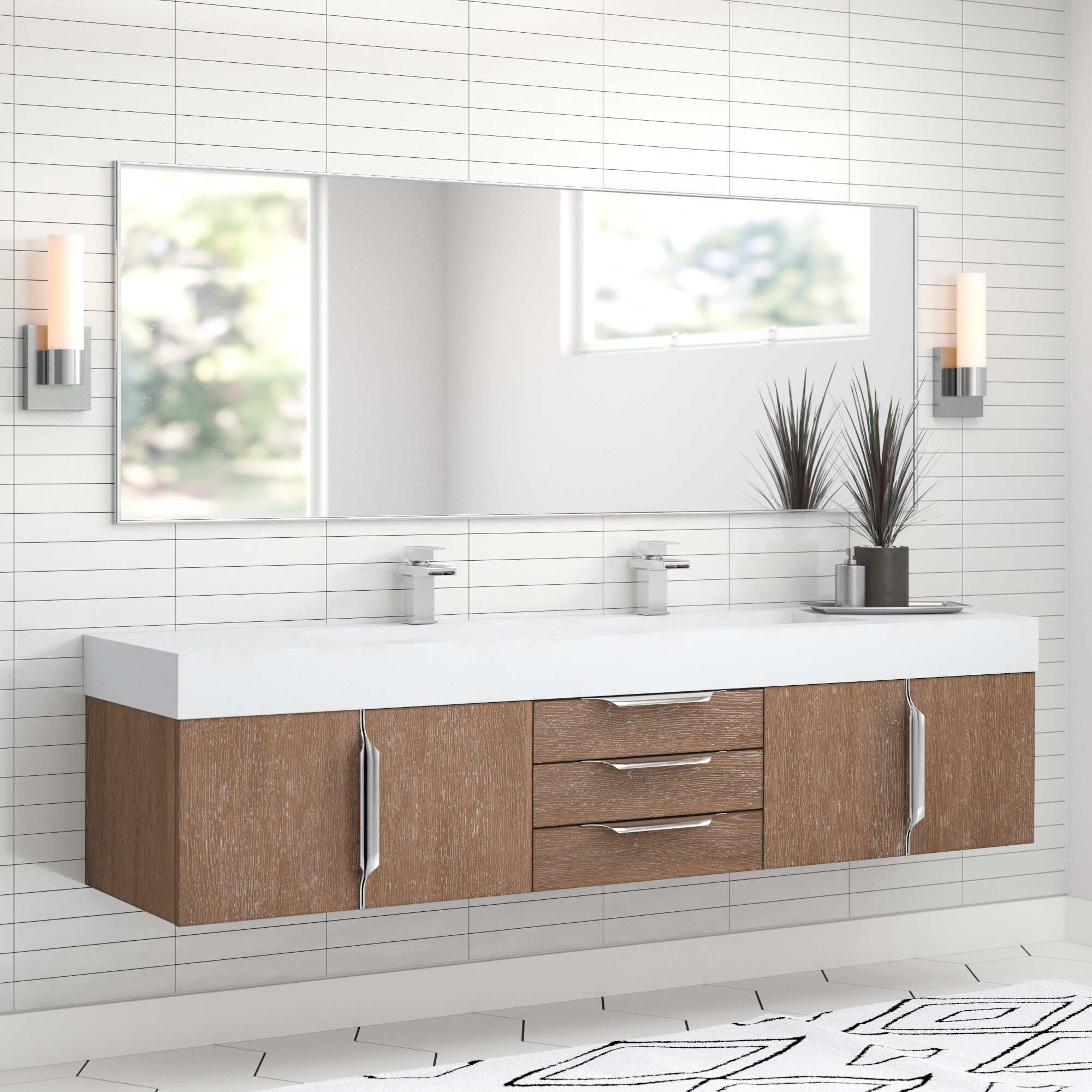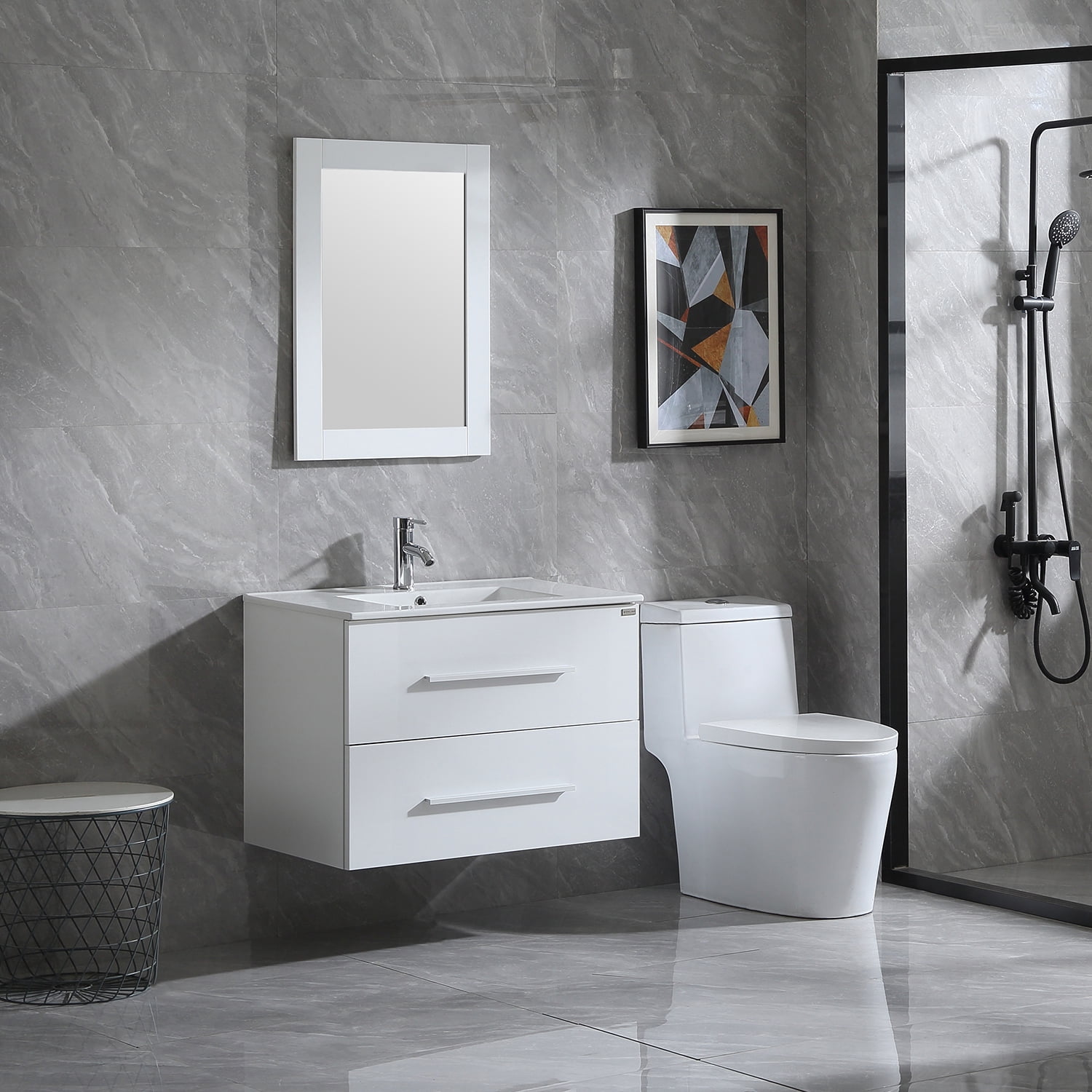Understanding Floating Vanity Cabinet Plans

Floating vanity cabinets have gained immense popularity in modern bathroom design, offering a contemporary and sleek aesthetic. They create an illusion of spaciousness, making the bathroom appear larger and more inviting.
Advantages of Floating Vanity Cabinets
Floating vanity cabinets provide several advantages, making them a desirable choice for bathroom design.
- Enhanced Visual Appeal: Floating vanities create a clean and minimalist look, enhancing the overall aesthetics of the bathroom. They provide a sense of openness and spaciousness, especially in smaller bathrooms.
- Easy Cleaning: The absence of legs or a base allows for easier cleaning under the vanity. The floor space beneath the cabinet remains unobstructed, making it simpler to sweep, mop, or vacuum.
- Increased Storage Space: Floating vanities often feature drawers and shelves, maximizing storage capacity. They provide ample space for toiletries, towels, and other bathroom essentials.
- Versatility: Floating vanities come in various sizes, materials, and styles, offering a wide range of options to suit different bathroom layouts and design preferences.
Types of Floating Vanity Cabinets
Floating vanity cabinets are available in a wide variety of styles, materials, and designs to cater to different bathroom aesthetics and preferences.
- Materials: Floating vanities are commonly crafted from materials like wood, acrylic, and laminate.
- Wood: Solid wood vanities offer durability, natural beauty, and a timeless appeal. Popular choices include oak, maple, cherry, and walnut.
- Acrylic: Acrylic vanities are known for their sleek and modern look. They are also resistant to moisture and easy to clean.
- Laminate: Laminate vanities are a budget-friendly option that offers a variety of finishes and colors. They are durable and water-resistant.
- Styles: Floating vanities can be designed in various styles, including contemporary, modern, traditional, and rustic.
- Contemporary: Contemporary vanities feature clean lines, minimalist designs, and often incorporate metal accents.
- Modern: Modern vanities emphasize functionality and simplicity. They often feature sleek finishes and geometric shapes.
- Traditional: Traditional vanities offer a classic and elegant look with intricate details and ornate carvings.
- Rustic: Rustic vanities embrace natural materials like reclaimed wood and distressed finishes, creating a warm and inviting atmosphere.
Essential Components of a Floating Vanity Cabinet Plan, Floating vanity cabinet plans
A comprehensive floating vanity cabinet plan should include detailed information about the cabinet’s dimensions, materials, and construction process.
- Cabinet Dimensions: The plan should specify the exact width, depth, and height of the cabinet. It should also include the dimensions of any drawers, shelves, or other internal components.
- Materials: The plan should list the specific materials to be used for the cabinet, including the type of wood, acrylic, or laminate. It should also specify the finishes, such as paint, stain, or varnish.
- Construction Process: The plan should provide a step-by-step guide to the construction process, outlining the necessary tools, techniques, and assembly instructions. It should also include details about the installation process, including the mounting brackets and hardware.
- Sink and Faucet Specifications: The plan should include the dimensions and specifications of the sink and faucet to be used with the vanity. This ensures that the sink and faucet are compatible with the cabinet and the overall bathroom design.
Planning and Designing Your Floating Vanity Cabinet: Floating Vanity Cabinet Plans

Planning and designing your floating vanity cabinet is an exciting process that allows you to create a stylish and functional bathroom space. It involves careful consideration of various factors, including space constraints, plumbing access, and desired features. A well-designed plan will ensure that your floating vanity cabinet fits seamlessly into your bathroom and meets your specific needs.
Factors to Consider
When planning your floating vanity cabinet, several factors are crucial to ensure a successful outcome. These factors include:
- Space Constraints: The available space in your bathroom is a primary consideration. Measure the width, depth, and height of the area where you intend to install the floating vanity. This will determine the maximum size of the cabinet you can accommodate.
- Plumbing Access: Ensure easy access to the plumbing connections behind the vanity. Consider the location of the sink drain, water supply lines, and any existing pipes or fixtures.
- Desired Features: Think about the features you want in your floating vanity cabinet, such as storage space, countertop material, sink style, and lighting.
Creating a Detailed Plan
A detailed plan is essential for building a floating vanity cabinet that meets your specific requirements. The plan should include:
- Measurements: Take precise measurements of the space where the vanity will be installed. This includes the width, depth, and height of the cabinet, as well as the location of any plumbing fixtures or obstructions.
- Materials List: Create a list of all the materials you will need, including wood, hardware, countertop material, sink, and any other accessories. Consider the type of wood, its thickness, and any special finishes or treatments you require.
- Cut List: Prepare a cut list for all the wood pieces needed for the cabinet. This will help you to efficiently cut the wood and ensure that all the pieces are the correct size.
Designing a Floating Vanity Cabinet Plan
To illustrate the planning process, let’s consider a bathroom with a limited space and a desire for a modern, minimalist design. The user wants a floating vanity cabinet with ample storage and a sleek countertop. Here’s a sample plan:
Measurements
- Width: 48 inches
- Depth: 22 inches
- Height: 34 inches
Materials List
- Wood: 3/4-inch plywood (for the cabinet frame, shelves, and doors), 1/2-inch plywood (for the back panel)
- Countertop: Quartz or engineered stone
- Sink: Undermount ceramic sink
- Hardware: Cabinet hinges, drawer slides, door pulls, and mounting brackets
- Finishing Materials: Stain or paint, sealant, and clear coat
Cut List
| Part | Quantity | Dimensions |
|---|---|---|
| Cabinet Side Panels | 2 | 22″ x 34″ |
| Cabinet Bottom Panel | 1 | 48″ x 22″ |
| Cabinet Top Panel | 1 | 48″ x 22″ |
| Shelf | 2 | 46″ x 20″ |
| Door | 2 | 20″ x 20″ |
| Back Panel | 1 | 48″ x 34″ |
This plan provides a basic framework for designing a floating vanity cabinet. It can be customized based on your specific needs and preferences.
Building and Installing Your Floating Vanity Cabinet

With your meticulously crafted plan in hand, it’s time to bring your floating vanity cabinet to life. This section will guide you through the construction process, from assembling the cabinet to securing it to the wall. We’ll also explore various finishing and styling options to complete your dream vanity.
Constructing the Cabinet
Building your floating vanity cabinet is a rewarding process that allows you to customize it to your exact specifications. The following steps provide a comprehensive guide:
- Cutting and Assembling the Cabinet Components: Begin by carefully cutting the wood according to your plan, ensuring precise measurements. Use a saw, preferably a table saw or miter saw, for clean and accurate cuts. Once the pieces are cut, assemble the cabinet using wood glue and screws. Make sure the joints are tight and secure.
- Creating the Cabinet Box: Assemble the sides, top, and bottom of the cabinet, forming a sturdy box. Use clamps to hold the pieces together while the glue dries. For added strength, consider using pocket hole screws or dowels to reinforce the joints.
- Adding the Cabinet Doors and Drawers: Once the cabinet box is complete, install the doors and drawers. Ensure the doors and drawers are properly aligned and function smoothly. If you’re using pre-made cabinet doors and drawers, follow the manufacturer’s instructions for installation.
- Installing the Sink and Faucet: Choose a sink that complements your vanity’s design. Carefully mark and cut the countertop for the sink opening, ensuring a snug fit. Install the sink using the manufacturer’s instructions and secure it with sealant. Next, install the faucet, making sure the plumbing connections are tight and leak-free.
Installing the Vanity Cabinet
Securely installing your floating vanity cabinet requires careful planning and execution. The following steps Artikel the installation process:
- Locating the Wall Studs: Use a stud finder to locate the wall studs behind the desired location for your vanity. Mark the stud locations on the wall for accurate placement.
- Installing the Mounting Brackets: Attach sturdy mounting brackets to the wall studs using heavy-duty screws. Ensure the brackets are level and securely fastened to the wall. The number of brackets needed will depend on the size and weight of your vanity.
- Attaching the Cabinet to the Brackets: Once the brackets are installed, carefully lift the vanity cabinet and attach it to the brackets using screws or bolts. Ensure the cabinet is level and secure before proceeding.
Finishing and Styling
With your floating vanity cabinet constructed and installed, it’s time to add the finishing touches that will enhance its beauty and functionality.
- Painting or Staining: Choose a paint or stain that complements your bathroom’s decor. Apply multiple coats for a smooth and durable finish. Ensure proper ventilation and allow the paint or stain to dry completely before moving on.
- Installing Hardware: Select knobs, pulls, or handles that complement the style of your vanity. Install them securely using screws or adhesives. Ensure the hardware is properly aligned and functional.
- Choosing a Countertop: Select a countertop material that suits your budget and aesthetic preferences. Popular choices include granite, marble, quartz, laminate, and solid surface. The countertop should be durable, easy to clean, and complement the overall style of your vanity.
Floating vanity cabinet plans offer a sleek and modern look for your bathroom, maximizing floor space and creating a sense of openness. If you’re looking for additional storage, consider incorporating an 18 inch wide linen cabinet alongside your vanity. This can provide a dedicated space for towels, toiletries, and other essentials, keeping your bathroom organized and clutter-free.
When planning your floating vanity cabinet design, remember to factor in the dimensions and placement of any additional storage solutions for a cohesive and functional space.
Floating vanity cabinets offer a sleek and modern look for your bathroom, and while you can find pre-made options, you might prefer the customization and cost savings of a DIY project. If you’re looking for the right materials to get started, you might find inspiration in the selection of unfinished pantry cabinets available at Menards, which offer a great starting point for building your own vanity.
With a little creativity and some basic woodworking skills, you can easily adapt these cabinets to create a unique and functional vanity that perfectly complements your bathroom style.
